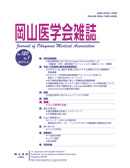

Journal of Okayama Medical Association
Published by Okayama Medical Association<Availability>
Full-text articles are available 3 years after publication.
Permalink : http://escholarship.lib.okayama-u.ac.jp/16799
Anatomical studies on the Vaterian bile duct and the pancreatic duct for successful endoscopic retrograde cholangio-pancreatography
Tsurumi, Tetsuya
Published Date
1979-02-28
Abstract
Comparative studies between the shape of the Vaterian papilla, appearance of the orifice, and the course of the intraduodenal bile duct and the pancreatic duct were made on fifty-eight autopsy materials in order to improve the success rate of selective cholangiography by the endoscopic retrograde method. The following results were obtained: 1) The Vaterian papilla was classified into five types according to its appearance. In each type, an attempt was made to measure the angle between the bile/pancreatic duct and a longitudinal axis on the surface paralell to the inner duodenal surface at the orifice of the major papilla. 2) The orifice of the papilla was classified into one of three types according to the macroscopic appearance. The appearance of the orifice was classified into further ten subtypes using a magnifying lens. The interrelationship of the three major types and the ten subtypes was evaluated. 3) It was demonstrated that both the site and the direction of cannulation at the orifice of the major papilla had to be carefully fitted to both the shape of the papilla and the appearance of the orifice to obtain a successful cholangiography and/or pancreatography. Some important points to be observed for successful cannulation are described in relation to the type of the major papilla and of the orifice. 4) A common channel was observed in 61 percent of cases. 5) A widely separated type of orifice (Mehnen I type) was observed in three, 5.3 percent, of cases.
Keywords
内視鏡的膵胆管造影成功率
十二指腸主乳頭
膵胆管末端部走行
成功率関係因子
ISSN
0030-1558
NCID
AN00032489
